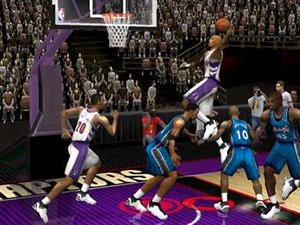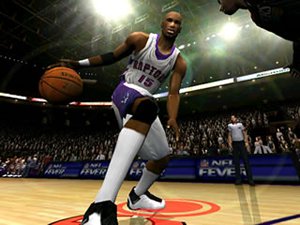Half-man, half-amazing game.
Sports game endorsements are guided purely by here-and-now fame. Usually it’s
fine because most megastars wind up as legends, but every once in a while, a game
company latches on to a fly-by-night success story, slaps his or her face on the
box cover, sends out a bazillion press releases announcing the deal, and figures
that the famous mug alone will sell a half-million copies.
Then
it turns out that Buster
Douglas is a chump. D’oh!
But in the case of NBA Inside Drive 2002, Microsoft showed some brains
when they went with Vince Carter, arguably the most exciting player in the league.
They also showed some skills with the rock in this decent if unspectacular entry
into the Xbox b-ball scene. It’s just too bad it doesn’t have NBA
2K2‘s A.I….and I don’t mean Allen Iverson on the cover.
The Inside Drive series started on the PC, but this version is built
very much from the ground up with Xbox playability and power in mind. The game
features all 29 NBA teams, complete with rosters updated in November 2001. Nice.
Sometimes it pays to be a little late.
The trimmings, though, are a little thin. You can play in Exhibition, Season,
or Playoff modes. That’s it. No One on One mode, no Three Point Contest, no
“Street” mode – it’s just the bare necessities. I suppose that’s not really
such a bad thing, since the extra modes in other games are often bland afterthoughts.
Still, it would have been nice to see the same care taken with this as with
Microsoft’s other big sports title NFL Fever,
which at least featured a bunch of Fantasy teams to play against and unlock.
Though the garnish is light, the entrée is adequate. The gameplay in Inside
Drive 2002 is pretty solid. Teams don’t really follow their real-life tendencies
as well as in NBA 2K2, but the game makes up for its somewhat unimaginative
AI with its excellent control options.
Typical moves like stealing, blocking and box-out stance are of course in
here, but so are nice touches like a ‘take a charge’ button, which sometimes
actually works. Deke moves aren’t simply spins and behind the back dribbles.
You can jab step, fake passes, bust out crossovers or even lose defenders with
a hesitation dribble. Playing in the paint also carries some new additions like
step-out moves, Karl Malone style. It isn’t all hook shots down there, you know.
To complement the in-game action, Microsoft obviously spent some time thinking about ways to better the coaching aspect. The result is a real-time coaching option that lets you change strategies without having to sort through options screens. Just use the D-pad to scroll through a small onscreen side menu to choose plays, switch up the team defense and defensive pressure, and even change tempos on the fly. It’s very handy and helps the game flow smoothly.
For the most part the gameplay is fine. Scores tend to be just about right
and when the action gets going it has a good feel. Still, there are some problems
here that are hard to ignore.
First and foremost is the propensity of blocked shots. I racked up 30 blocks
in my first outing set on 8 minute quarters. That’s about 20 too many. The second
time around I upped the difficulty and racked up a marginally less disturbing
26 blocks. Guys who have no business swatting the ball, like Laker point guard
Derek Fisher, act like Mark
Eaton. It’s silly.
 Which
Which
is also a good way to describe the AI – it ain’t great. Computer players don’t
react much like their real-life counterparts and don’t often run convincing
plays. The only real sign of intellect at work is towards the end of the game,
when the CPU will intentionally foul or bomb three pointers if it’s losing.
The delivery of the game is mixed; up close, players look fine (particularly
their faces), but you don’t play basketball games from eye level. The players
look doughy and a little awkward at the farther zooms, and though the animations
are terrific, the overall look is reminiscent of 32-bit basketball rather than
next-generation stuff, due in part to the crowd being made up of cheap-looking
sprite animations. The ball also tends to float in the air too much due to some
questionable physics, particularly during passes.
The play-by-play is not good, despite the veteran team of Kevin Calabro and
Marques Johnson. Marques blabs on and on about all sorts of stupid non-factoids
while Kevin is rife with hyperbole, constantly carrying on over the most basic
dunk. Both are repetitive and annoying and thank god for the options menu. Bob
Costas, where art though?
Oddly, there is no Custom player feature, so don’t even think about putting yourself in the game. Again, this is a very bare bones piece of software.
But not an inherently bad one. NBA Inside Drive 2002 may not have the
thoroughness of other b-ball titles, but it’s certainly not an airball. At least
it’s better than NBA Live 2002. Still, I wouldn’t
necessarily run out and buy it considering that a port of NBA 2K2 is
right around the corner.

-
In-game coaching
-
Good moves/control
-
Great animations
-
Bad commentary
-
Very bare bones
-
No Player Creator?










